Size Composition, Stability, and Distribution of Metal Nutrient Elements of Soil Aggregates of Eucalyptus Plantations with Different Thinning Intensities
Abstract
1. Introduction
2. Materials and Methods
2.1. Study Area
2.2. Experimental Methods
2.2.1. Plot Setup
2.2.2. Sample Collection
2.2.3. Sample Analysis
- (1)
- Analysis of physical and chemical properties of soil and aggregates
- (2)
- Soil aggregate size composition
- (3)
- Soil aggregate stability
- (4)
- Determination of metal nutrient elements
2.2.4. Data Statistics and Analysis
3. Results
3.1. Composition and Stability of Soil Aggregates
3.2. Metal Nutrient Element Content in Soil Aggregates
3.3. Metal Nutrient Element Reserves in Soil Aggregates
3.3.1. Reserves of Each Metal Nutrient Element
3.3.2. Relative Proportions of Metal Nutrient Element Reserves
3.3.3. Contribution Rates of Metal Nutrient Element Reserves
3.4. Relationships Between Metal Nutrient Elements in Soil Aggregates and Environmental Factors
3.4.1. Metal Nutrient Element Content in Soil Aggregates
3.4.2. Metal Nutrient Element Stocks in Soil Aggregates
4. Discussion
4.1. Composition and Stability of Soil Aggregates
4.2. Distribution of Soil Aggregate Nutrients
5. Conclusions
Author Contributions
Funding
Data Availability Statement
Conflicts of Interest
References
- Xie, Z.S.; Liang, X.; Liu, H.Y.; Deng, X.S.; Cheng, F. Nutrient element stocks and dynamic changes in stump–root systems of Eucalyptus urophylla × E. grandis. Forests 2024, 15, 1. [Google Scholar] [CrossRef]
- Resquin, F.; Navarro-Cerrillo, R.M.; Carrasco-Letelier, L.; Casnati, C.R.; Bentancor, L. Evaluation of the nutrient content in biomass of Eucalyptus species from short rotation plantations in Uruguay. Biomass Bioenergy 2020, 134, 1–16. [Google Scholar] [CrossRef]
- Gao, G.N.; Huang, X.M.; Xu, H.C.; Wang, Y.; Shen, W.J.; Zhang, W.; Yan, J.L.; Su, X.Y.; Liao, S.S.; You, Y.M. Conversion of pure Chinese fir plantation to multi-layered mixed plantation enhances the soil aggregate stability by regulating microbial communities in subtropical China. For. Ecosyst. 2022, 9, 100078. [Google Scholar] [CrossRef]
- Yu, Q.B.; Xu, L.Y.; Wang, M.Y.; Xu, S.X.; Sun, W.X.; Yang, J.Z.; Shi, Y.J.; Shi, X.Z.; Xie, X.Q. Decreased soil aggregation and reduced soil organic carbon activity in conventional vegetable fields converted from paddy fields. Eur. J. Soil Sci. 2022, 73, e13222. [Google Scholar] [CrossRef]
- Wang, J.Y.; Deng, Y.S.; Li, D.Y.; Liu, Z.F.; Wen, L.L.; Huang, Z.G.; Jiang, D.H.; Lu, Y.P. Soil aggregate stability and its response to overland flow in successive Eucalyptus plantations in subtropical China. Sci. Total Environ. 2022, 807, 151000. [Google Scholar] [CrossRef]
- Ye, Y.Q.; Wang, H.; Luan, J.W.; Ma, J.H.; Ming, A.G.; Niu, B.L.; Liu, C.J.; Freedman, Z.; Wang, J.X.; Liu, S.R. Nitrogen-fixing tree species modulate species richness effects on soil aggregate-associated organic carbon fractions. For. Ecol. Manag. 2023, 546, 121315. [Google Scholar] [CrossRef]
- Shi, K.; Liao, J.H.; Zou, X.M.; Chen, H.Y.H.; Delgado-Baquerizo, M.; Wanek, W.; Ni, J.P.; Ren, T.T.; Zhang, C.; Yan, Z.M.; et al. Forest development induces soil aggregate formation and stabilization: Implications for sequestration of soil carbon and nitrogen. Catena 2024, 246, 108363. [Google Scholar] [CrossRef]
- Garca-Oliva, F.; Sanford, R.L.J.; Kelly, E.F. Effects of slash-burn management on soil aggregate organic C and N in a tropical deciduous forest. Geoderma 1999, 88, 1–12. [Google Scholar] [CrossRef]
- He, Y.; Xu, Z.H.; Chen, C.R.; Burton, J.; Ma, Q.; Ge, Y.; Xu, J.M. Using light fraction and macroaggregate associated organic matters as early indicators for management-induced changes in soil chemical and biological properties in adjacent native and plantation forests of subtropical Australia. Geoderma 2008, 147, 116–125. [Google Scholar] [CrossRef]
- Wang, L.F.; Xiao, W.W.; Wang, S.L. Changes of soil aggregate stability and carbon-nitrogen distribution after artificial management of natural secondary forests. J. Beijing For. Univ. 2022, 44, 97–106. [Google Scholar]
- Wang, X.H.; Yang, Z.J.; Liu, X.F.; Yang, Y.S.; Wu, J.J.; Fu, L.C.; Chen, T.; Li, W. Effects of natural forest converted to plantations on soil organic carbon distribution and stability of aggregates in middle-subtropics of China. J. Soil Water Conserv. 2014, 28, 177–182,189. [Google Scholar]
- Guo, Z.X.; Li, R.N.; Chen, S.D. Effects of subtropical natural forest conversion on soil aggregate stability. J. Subtrop. Resour. Environ. 2023, 18, 62–69+85. [Google Scholar]
- Pan, J.C.; Liu, C.; Dong, Z.; Wu, Q.C.; Li, H.L.; Li, Y.B.; Zhang, M.L.; Yang, Z.J. Distribution characteristics of soil aggregates and soil organic carbon in Populus artificial forest with different forest ages in Yellow River flood plain. Res. Soil Water Conserv. 2022, 29, 25–30+37. [Google Scholar]
- Wang, C.; Hu, H.B.; Fan, Z.; Lian, J.W. Effects of Quercus acutissima age on composition and organic carbon content of soil water-stable aggregates. Soils 2019, 51, 979–985. [Google Scholar]
- Zhang, Y.; Li, H.T.; Wei, Z.C.; Liu, C.H.; Jiang, Z.K.; Ma, X.Q. Soil organic matter characteristics and aggregate stability in different development stages of Chinese fir plantation. Chin. J. Ecol. 2016, 35, 2029–2037. [Google Scholar]
- Yang, X.; Xiao, W.F.; Zeng, L.X.; Lei, L.; Li, C.L. Nutrient content and microbial community characteristics of soil aggregates of different sizes in pure and mixed forests of Masson pine. Terr. Ecosyst. Conserv. 2023, 3, 10–19. [Google Scholar]
- Yan, Y.; Cui, Y.H.; Fan, R.Y.; Pan, C.L.; Jiang, C.Y.; Hao, J.W.; Ye, S.M. Soil aggregate stability and distribution characteristics of organic nitrogen components in Eucalyptus pure and mixed forests. J. Cent. South Univ. For. Technol. 2023, 43, 149–158. [Google Scholar]
- Xie, X.J.; Han, G.Z. Study on soil fractal features and anti-erodibility of soil water-stable aggregates under different Eucalyptus grandis plantations styles. Soils 2014, 46, 725–731. [Google Scholar]
- Das, S.; Bhattacharyya, R.; Das Saha, N.; Ghosh, A.; Khan, S.A.; Ahmed, N.; Dey, A.; Bhatia, A.; Pramanik, P.; Kumar, S.N.; et al. Soil aggregate-associated carbon and organic carbon pools as affected by conversion of forest lands to agriculture in an acid soil of India. Soil Till. Res. 2022, 223, 105443. [Google Scholar]
- Hu, Y.; Li, Y.; Hou, Y.L. Effects of land use types on stability and organic carbon of soil aggregates in Minjiang River Valley. Res. Soil Water Conserv. 2018, 25, 22–29. [Google Scholar]
- Lan, J.C.; Long, Q.X.; Huang, M.Z.; Jiang, Y.X.; Hu, N. Afforestation-induced large macroaggregate formation promotes soil organic carbon accumulation in degraded Karst area. For. Ecol. Manag. 2022, 505, 119884. [Google Scholar]
- Bai, Y.X.; Zhou, Y.C.; Du, J.J.; Zhang, X.Y. Tree species identity affects nutrient accumulation and stoichiometric in soil aggregates in mixed plantations of subtropical China. Catena 2024, 236, 107752. [Google Scholar]
- Huang, Y.Z.; Wang, S.Q.; Ye, S.M. Effects of Cunninghamia lanceolata stand types on the changes of aggregate-related organic carbon and nutrients in surface soil. Chin. J. Appl. Ecol. 2020, 31, 2857–2865. [Google Scholar]
- Chen, T.; Cheng, R.M.; Xiao, W.F.; Zeng, L.X.; Shen, Y.F.; Wang, L.J.; Sun, P.F.; Zhang, M.; Li, J. Response of nitrogen mineralization in soil aggregates to changes in soil moisture and temperature in the Three Gorges Reservoir Area’s typical plantation. For. Res. 2024, 37, 27–38. [Google Scholar]
- Wang, Y.; Chen, Z.F.; Huang, K.T.; Chen, X.L.; Chen, L.J.; Wang, Y.Q.; Ke, Q.; Wu, L.C. Effects of non-burning management on soil aggregate nutrients and stability in Eucalyptus plantations. Chin. J. Soil Sci. 2023, 54, 614–625. [Google Scholar]
- Baumert, V.L.; Vasilyeva, N.A.; Vladimirov, A.A.; Meier, I.C.; Kögel-Knabner, I.; Mueller, C.W. Root exudates induce soil macroaggregation facilitated by fungi in subsoil. Front. Env. Sci. 2018, 6, 140. [Google Scholar]
- Kawakami, T.; Katayama, N.; Nishizawa, K.; Kobayashi, Y.; Suzuki, K.F.; Mori, A.S.; Kobayashi, M. Recovery of earthworm community and development of soil aggregates on scarification site. Jpn. For. Soc. Congr. 2022, 133, 490. [Google Scholar]
- Zhang, H.Q.; Schrader, S. Earthworm effects on selected physical and chemical properties of soil aggregates. Biol. Fert. Soils 1993, 15, 229–234. [Google Scholar]
- Ma, L.; Shao, M.A.; Li, J. Soil aggregate organic carbon and clover root characteristics as affected by earthworms (Metaphire guillelmi). Land Degrad. Dev. 2022, 33, 3594–3602. [Google Scholar]
- Fonte, S.J.; Quintero, D.C.; Velásquez, E.; Lavelle, P. Interactive effects of plants and earthworms on the physical stabilization of soil organic matter in aggregates. Plant Soil 2012, 359, 205–214. [Google Scholar]
- Sun, X.Y. Pedology, 2nd ed.; China Forestry Publishing House: Beijing, China, 2021. [Google Scholar]
- Li, X.H.; Wang, R.H.; Liu, K.L.; Zhou, Y.H.; Hu, J.Y. Effects of thinning on tree growth and soil physiochemical properties in Cunninghamia lanceolata plantation. J. For. Res. 2023, 28, 251–259. [Google Scholar] [CrossRef]
- Li, Y.; Hong, S.X.; Fang, S.Z.; Cui, G.C. Thinning promotes litter decomposition and nutrient release in poplar plantations via altering the microclimate and understory plant diversity. Ann. For. Res. 2023, 66, 3–18. [Google Scholar]
- Mao, Z.H.; Zhu, J.J.; Liu, Z.G.; Tan, H.; Cao, B. Effects of thinning on plant species diversity and composition of understory herbs in a larch plantation. Front. For. China 2008, 3, 422–428. [Google Scholar]
- Chen, R.Y.; Wei, P.; Liu, J.H. Utilization of compressed Chinese fir thinning wood. Chin. J. Appl. Ecol. 2005, 16, 2306–2310. [Google Scholar]
- Cheng, C.P.; Wang, Y.D.; Fu, X.L.; Xu, M.J.; Dai, X.Q.; Wang, H.M. Thinning effect on understory community and photosynthetic characteristics in a subtropical Pinus massoniana plantation. Can. J. For. Res. 2017, 47, 1104–1115. [Google Scholar]
- Shen, Y.F.; Wang, N.; Cheng, R.M.; Xiao, W.F.; Yang, S.; Guo, Y. Short-term effects of low intensity thinning on the fine root dynamics of Pinus massoniana plantations in the three Gorges Reservoir Area, China. Forests 2017, 8, 428. [Google Scholar] [CrossRef]
- Moore, M.M.; Casey, C.A.; Bakker, J.D.; Springer, J.D.; Fulé, P.Z.; Laughlin, C.D.C. Herbaceous vegetation responses (1992—2004) to restoration treatments in a ponderosa pine forest. Rangel. Ecol. Manag. 2006, 59, 135–144. [Google Scholar]
- Zheng, M.H.; Zhou, Z.H.; Luo, Y.Q.; Zhao, P.; Mo, J.M. Global pattern and controls of biological nitrogen fixation under nutrient enrichment: A meta-analysis. Glob. Change Biol. 2019, 25, 3018–3030. [Google Scholar]
- Fu, X.L.; Yang, F.T.; Wang, J.L.; Di, Y.B.; Dai, X.Q.; Zhang, X.Y.; Wang, H.M. Understory vegetation leads to changes in soil acidity and in microbial communities 27years after reforestation. Sci. Total Environ. 2015, 502, 280–286. [Google Scholar]
- Chen, K.X.; Ye, Y.C.; Mo, L.J.; Huang, Q.L.; Shen, D.C.; Liu, S.S. Effects of thinning on physical and chemical characteristics, soil microorganism and soil enzyme activities of Eucalyptus urophylla plantation. Southwest China J. Agric. Sci. 2017, 30, 2277–2283. [Google Scholar]
- Yan, Z.P. Effects of Different Tending Thinning Intensities on Stands and Soil Properties of Eucalyptus Plantations. Master’s Thesis, Central South University of Forestry and Technology, Changsha, China, 2019. [Google Scholar]
- Moorhead, D.L.; Rinkes, Z.L.; Sinsabaugh, R.L.; Weintraub, M.N. Dynamic relationships between microbial biomass, respiration, inorganic nutrients and enzyme activities: Informing enzyme-based decomposition models. Front. Microbiol. 2013, 4, 223. [Google Scholar] [CrossRef] [PubMed]
- Wu, R.; Cheng, X.Q.; Han, H.R. The Effect of forest thinning on soil microbial community structure and function. Forests 2019, 10, 352. [Google Scholar] [CrossRef]
- Zhou, Y.; Chen, Y.X.; Zou, R.; Zhou, W. Effect of stand density on characteristics of soil aggregates in Pinus tabuliformis plantation in Badaling area, Beijing. J. Southwest For. Univ. 2016, 3, 25–30. [Google Scholar]
- Candan, F.; Broquen, P. Aggregate stability and related properties in NW Patagonian Andisols. Geoderma 2009, 154, 42–47. [Google Scholar] [CrossRef]
- Shen, Y.F.; Cheng, R.M.; Xiao, W.F.; Yang, S. Effects of understory removal and thinning on soil aggregation, and organic carbon distribution in Pinus massoniana plantations in the three Gorges Reservoir Area. Ecol. Indic. 2021, 123, 107323. [Google Scholar] [CrossRef]
- Lv, L. Effects of thinning on soil aggregate, active organic carbon and microorganism of Larix gmelinii natural forest. Master’s Thesis, Northeast Forestry University, Harbin, China, 2017. [Google Scholar]
- Yu, J.X. Soil aggregate stability and nutrient distribution characteristics of Larix principis-rupprechtii plantations in Taiyue Mountain of Shanxi Province. Master’s Thesis, Beijing Forestry University, Beijing, China, 2019. [Google Scholar]
- Liu, S.M.; Tian, D.L.; Xiang, W.H.; Yan, W.D.; Liu, Y.G.; Hu, X.J. The impacts of thinning intensity on overland flow in a Chinese fir plantation. Acta Ecol. Sin. 2015, 35, 5769–5775. [Google Scholar]
- Cheng, X.R.; Xing, W.L.; Yuan, H.J.; Yu, M.K. Long-term thinning does not significantly affect soil water-stable aggregates and diversity of bacteria and fungi in Chinese fir (Cunninghamia lanceolata) plantations in eastern China. Forests 2018, 9, 687. [Google Scholar] [CrossRef]
- Zhou, C.J.; Wu, Z.L.; Zhou, X.N.; Qiu, R.H. Impact of cutting intensity on litter and soil physicochemical properties of mixed plantations of Cunninghamia lanceolata and broadleaved trees. Chin. J. Appl. Environ. Biol. 2022, 28, 145–151. [Google Scholar]
- Harmonized World Soil Database Version 2.0. Available online: https://openknowledge.fao.org/handle/20.500.14283/cc3823en (accessed on 25 March 2025).
- Lu, R.K. Analysis Methods of Soil Agricultural Chemistry; China Agricultural Scicnce and Technology Press: Beijing, China, 2000. [Google Scholar]
- Yang, Q.; Zhu, D.Y.; Chen, J.; Chen, H. Effects of vegetation restoration models on soil aggregate and organic carbon stock. J. For. Environ. 2022, 42, 631–639. [Google Scholar]
- Wu, J.; Yang, G.; Han, X.Y.; Wen, Y.Q.; Yang, Y.W.; Li, W.L.; Liu, Y. Effects of different plantations on soil aggregates in the Nayman sand region. Arid Zone Res. 2022, 39, 1832–1841. [Google Scholar]
- Zhang, Z.; Huang, Y.Z.; Zhang, C.; Ye, S.M.; Wang, S.Q. Distribution of phosphorus fractions in soil aggregates in Chinese fir plantations with different stand ages. Chin. J. Appl. Ecol. 2022, 33, 939–948. [Google Scholar]
- Wang, D.Y. Effects of density of Larix principis-rupprechtii plantation on organic carbon mineralization of soil aggregate. Master’s Thesis, Beijing Forestry University, Beijing, China, 2020. [Google Scholar]
- Fu, Y.; Li, G.L.; Zheng, T.H.; Li, B.Q.; Zhang, T. Splash detachment and transport of loess aggregate fragments by raindrop action. Catena 2017, 150, 154–160. [Google Scholar] [CrossRef]
- Hu, X.; Liu, L.Y.; Li, S.J.; Cai, Q.G.; Lü, Y.L.; Guo, J.R. Development of soil crusts under simulated rainfall and crust formation on a loess soil as influenced by polyacrylamide. Pedosphere 2012, 22, 415–424. [Google Scholar] [CrossRef]
- Huan, H.E.; Kang, B.J.; Yin, J.; Li, F.; Peng, D.; Li, G.J.; Zha, T.G. Effects of forest management measurements on soil aggregate stability and fine root distribution of Chinese fir in Huaying Mountains of East Sichuan. Chin. J. Soil Sci. 2024, 55, 351–359. [Google Scholar]
- Wang, S.S.; Bi, H.X.; Cui, Y.H.; Yun, H.Y.; Ma, X.Z.; Zhao, D.Y.; Hou, G.R. Key indexes and characteristics of soil anti-erodibility of Robinia pseudoacacia with different densities in loess region of western Shanxi Province, northern China. J. Beijing For. Univ. 2022, 44, 94–104. [Google Scholar]
- Zhang, Q.Y.; Shao, M.A.; Jia, X.X.; Zhang, C.C. Understory vegetation and drought effects on soil aggregate stability and aggregate-associated carbon on the loess plateau in China. Soil Sci. Soc. Am. J. 2018, 82, 106–114. [Google Scholar]
- Eynard, A.; Schumacher, T.E.; Lindstrom, M.J.; Malo, D.D. Aggregate sizes and stability in cultivated South Dakota Prairie Ustolls and Usterts. Soil Sci. Soc. Am. J. 2004, 68, 1360–1365. [Google Scholar]
- Amézketa, E. Soil aggregate stability: A review. J. Sustain. Agr. 1999, 14, 83–151. [Google Scholar]
- Tian, Y.; Lu, S.G. Amorphous iron oxides protect aggregate-associated organic carbon from microbial utilization and decomposition evidenced from the natural abundance of 13C. Soil Till. Res. 2023, 227, 105623. [Google Scholar]
- Lin, Z.; Huang, Z.G.; Liao, D.L.; Huang, W.X.; Huang, J.; Deng, Y.S. Effects of soil organic matter components and iron aluminum oxides on aggregate stability during vegetation succession in granite red soil eroded areas. J. Mt. Sci. 2022, 19, 2634–2650. [Google Scholar]
- Liu, K.H.; Lan, J.K.; Zhang, L.; Li, J.B. The features of red soil and their influences on natural environment in Guangxi Zhuang Autonomous Region. Agroenvironmental Prot. 2000, 19, 32–34. [Google Scholar]
- Lv, H.B.; Zeng, Z.T.; Yin, G.Q.; Zhao, Y.L. Analysis of mineral composition of red clay in Guangxi. J. Eng. Geol. 2012, 20, 651–656. [Google Scholar]
- Liu, X.Y.; Liu, P.; Liu, C. Variation characteristics of organic matters and nutrient elements in typical black soil. Geol. Resour. 2022, 31, 500–507. [Google Scholar]
- Shen, Q.; Wu, M.J.; Zhang, M.K. Accumulation and relationship of metals in different soil aggregate fractions along soil profiles. J. Environ. Sci. 2022, 115, 47–54. [Google Scholar] [CrossRef]
- Dincher, M.; Calvaruso, C.; Turpault, M.P. Major element residence times in humus from a beech forest: The role of element forms and recycling. Soil Biol. Biochem. 2020, 141, 107674. [Google Scholar] [CrossRef]
- Orlov, D.S.; Xie, P. The nature and formation mechanisms of metal-humic complexes. Adv. Soil Sci. 1991, 5, 29–34. [Google Scholar]
- Liu, Y.L.; Wang, P.; Wang, J.K. Formation and stability mechanism of soil aggregates: Progress and prospect. Acta Pedol. Sin. 2023, 60, 627–643. [Google Scholar]
- Baruah, M.K.; Upreti, M.C. Preferential uptake of Fe (III) by humic acid extracted from lignite. Fuel 1994, 73, 273–275. [Google Scholar] [CrossRef]
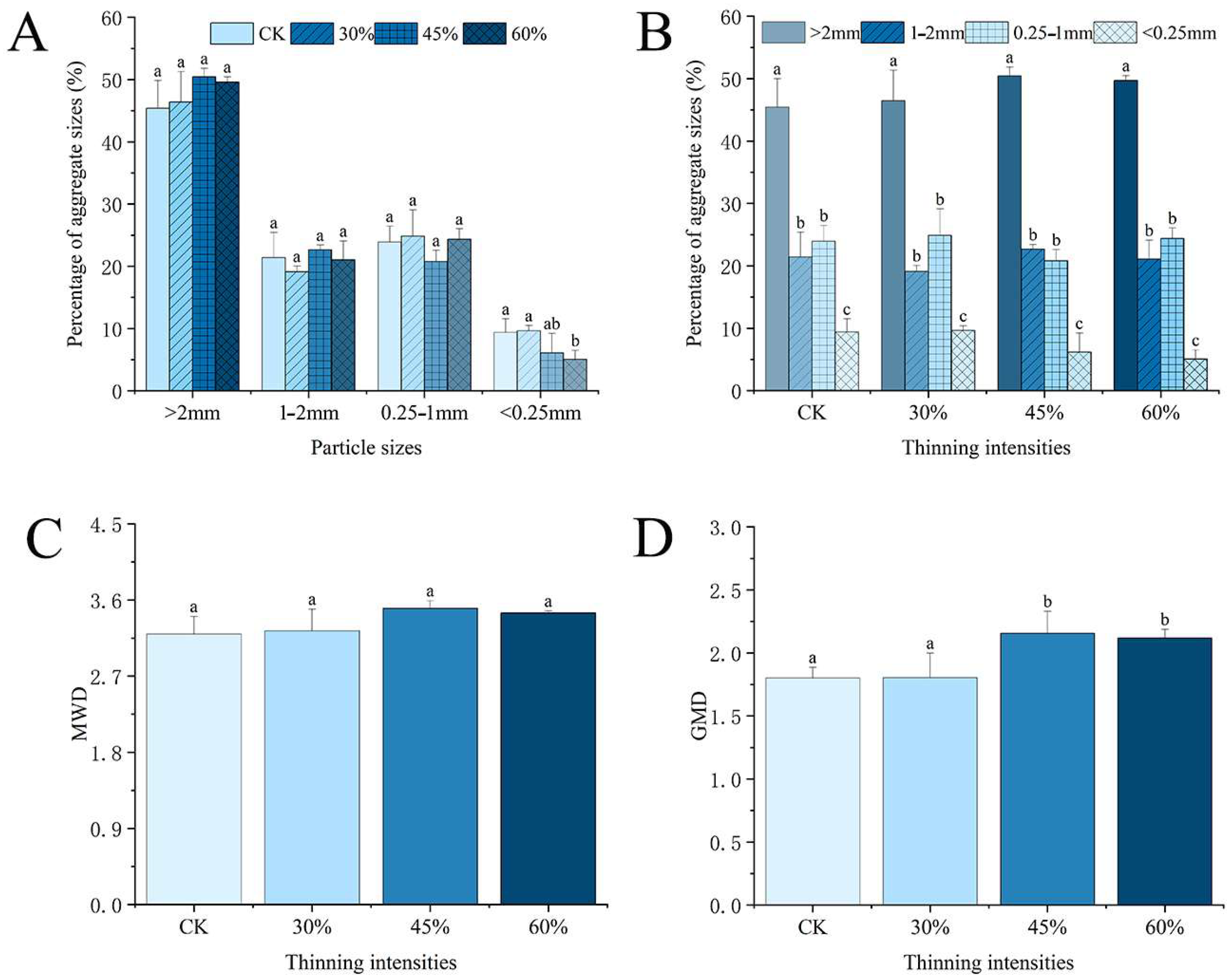
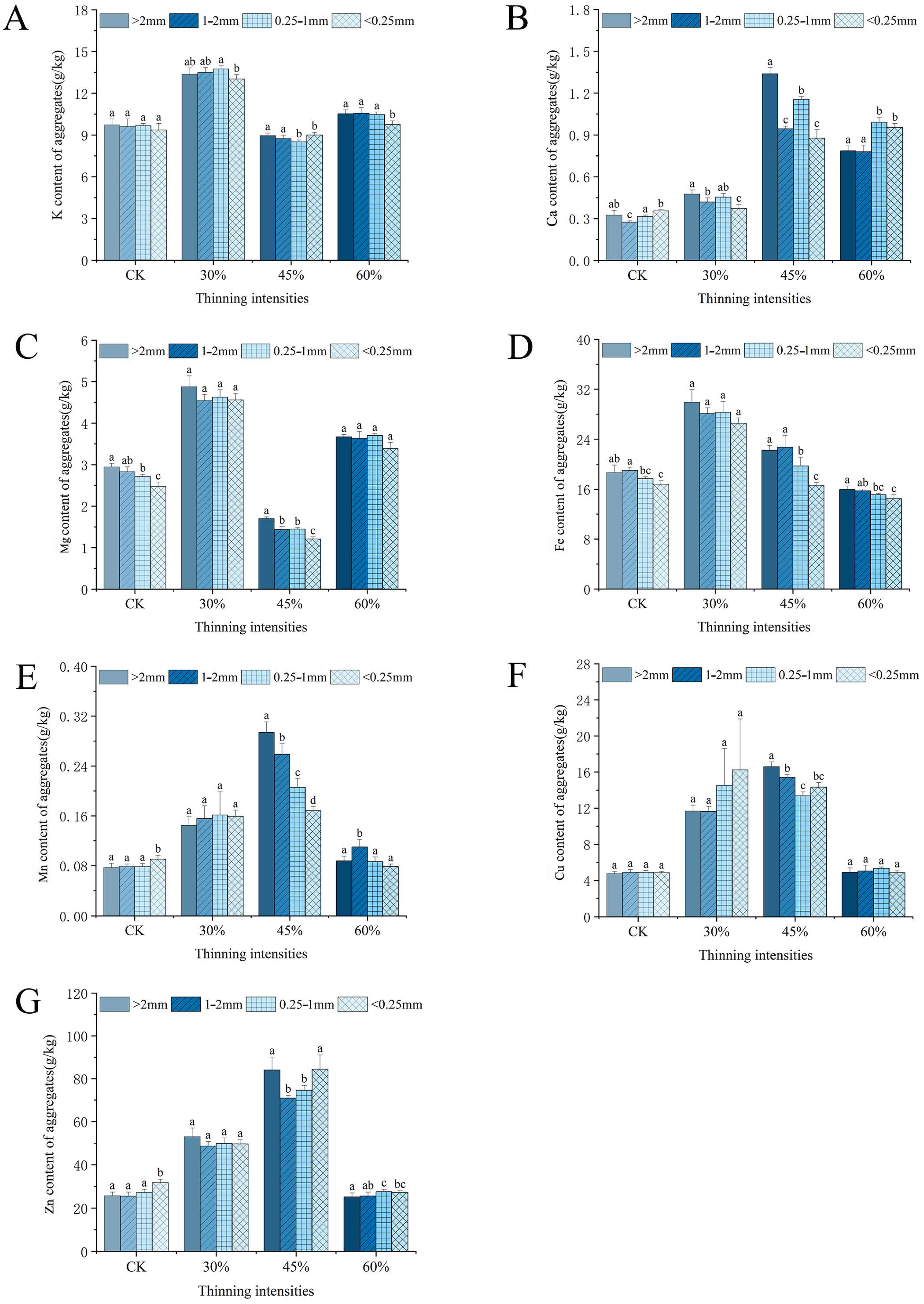
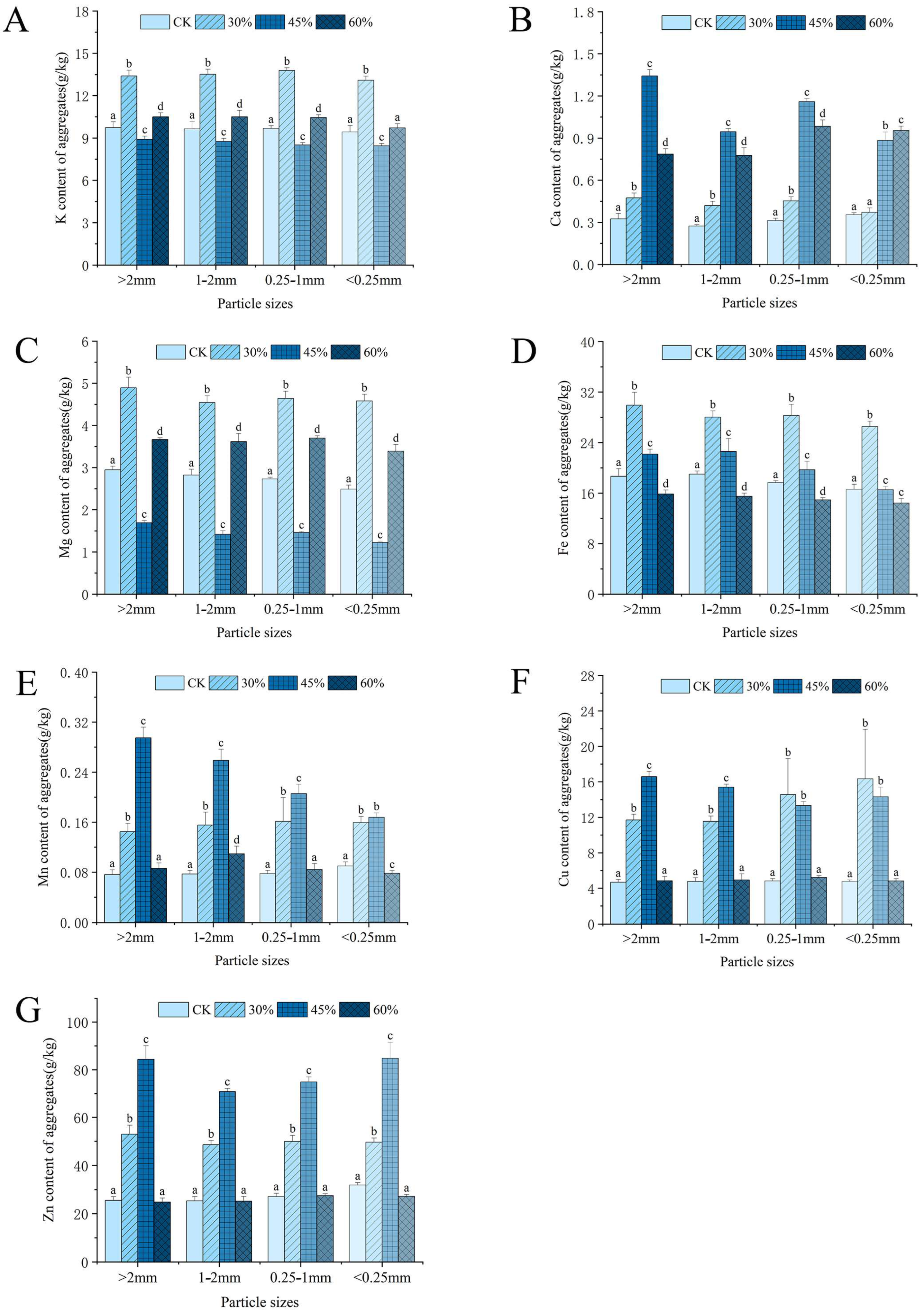
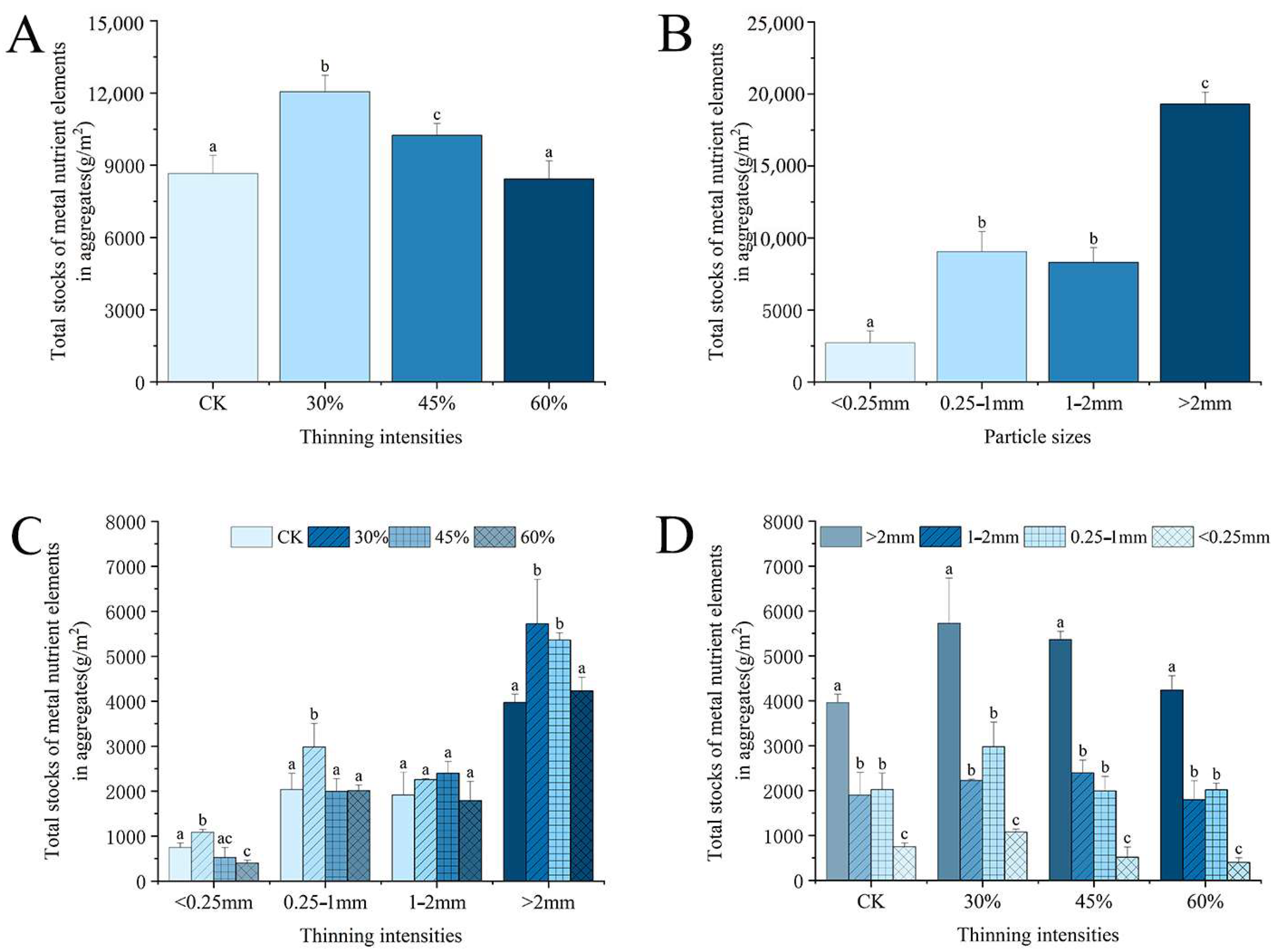
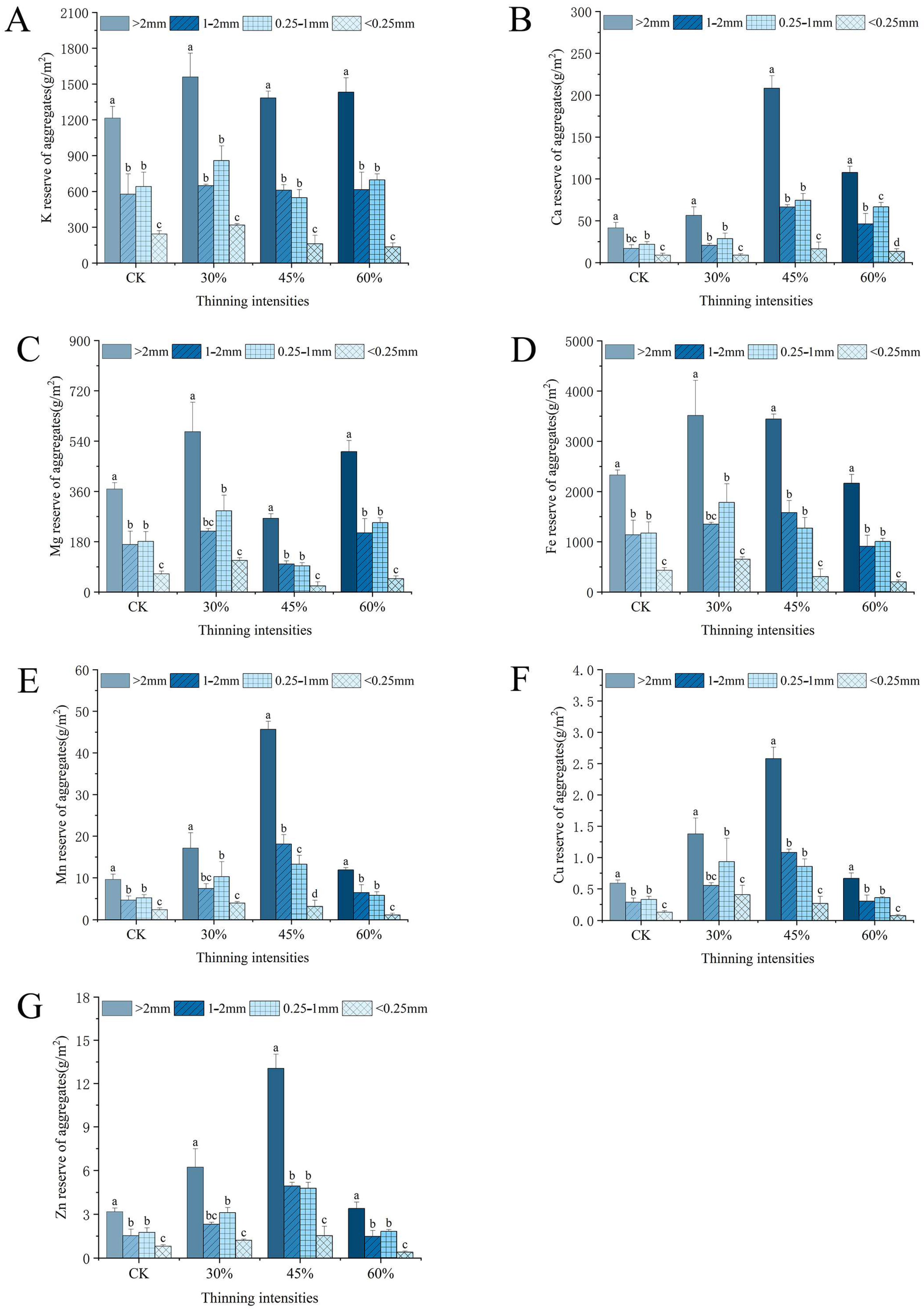
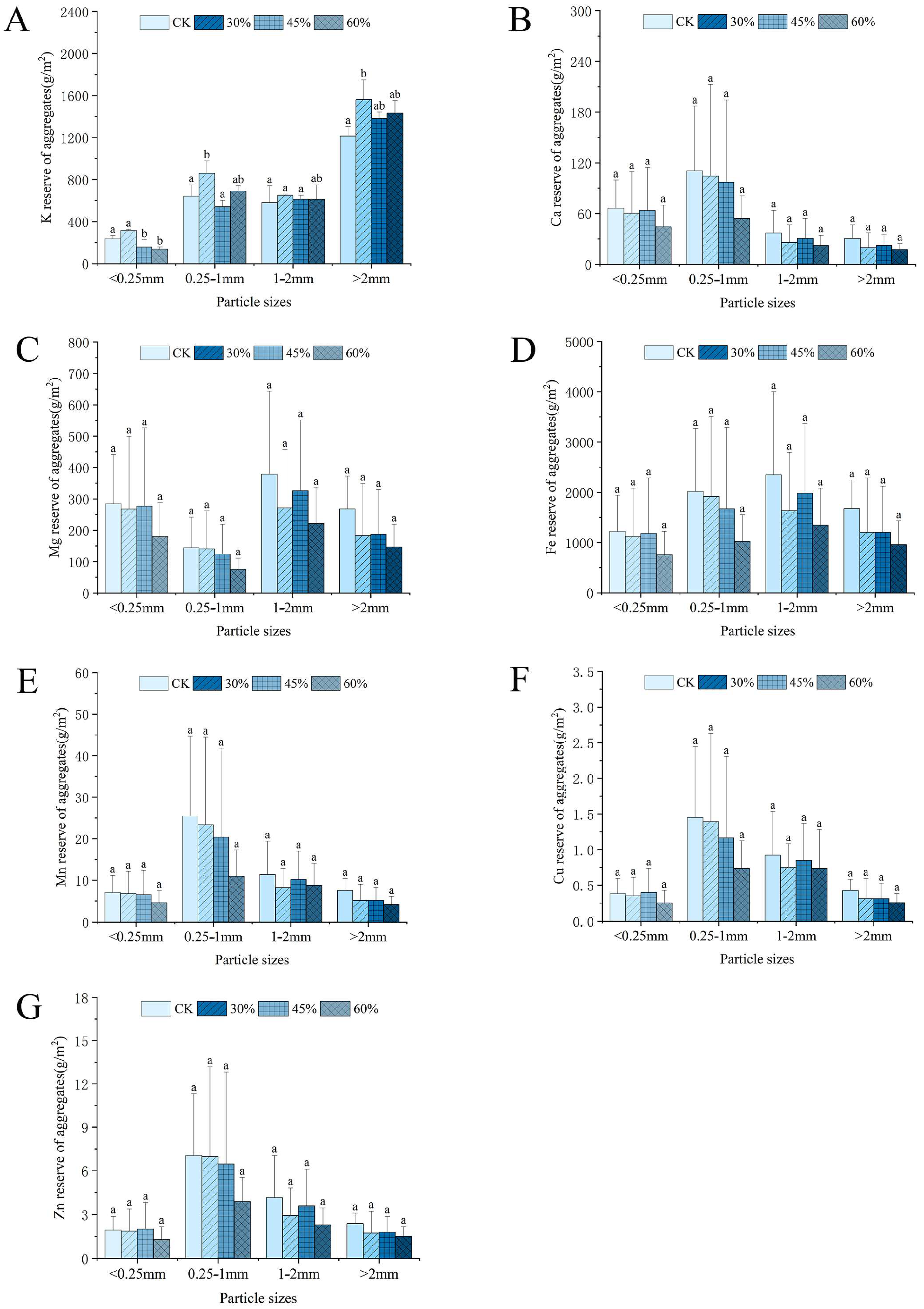

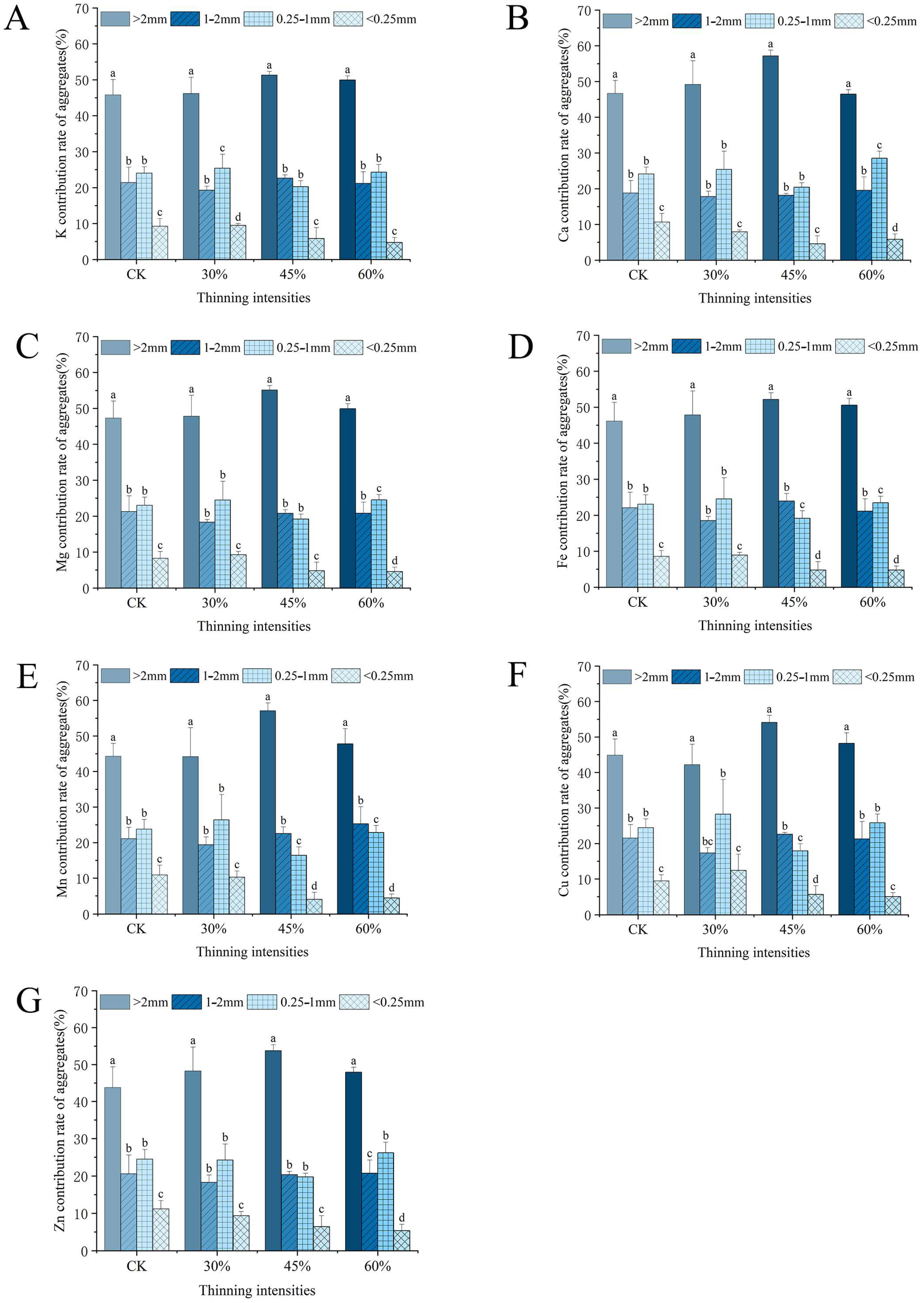
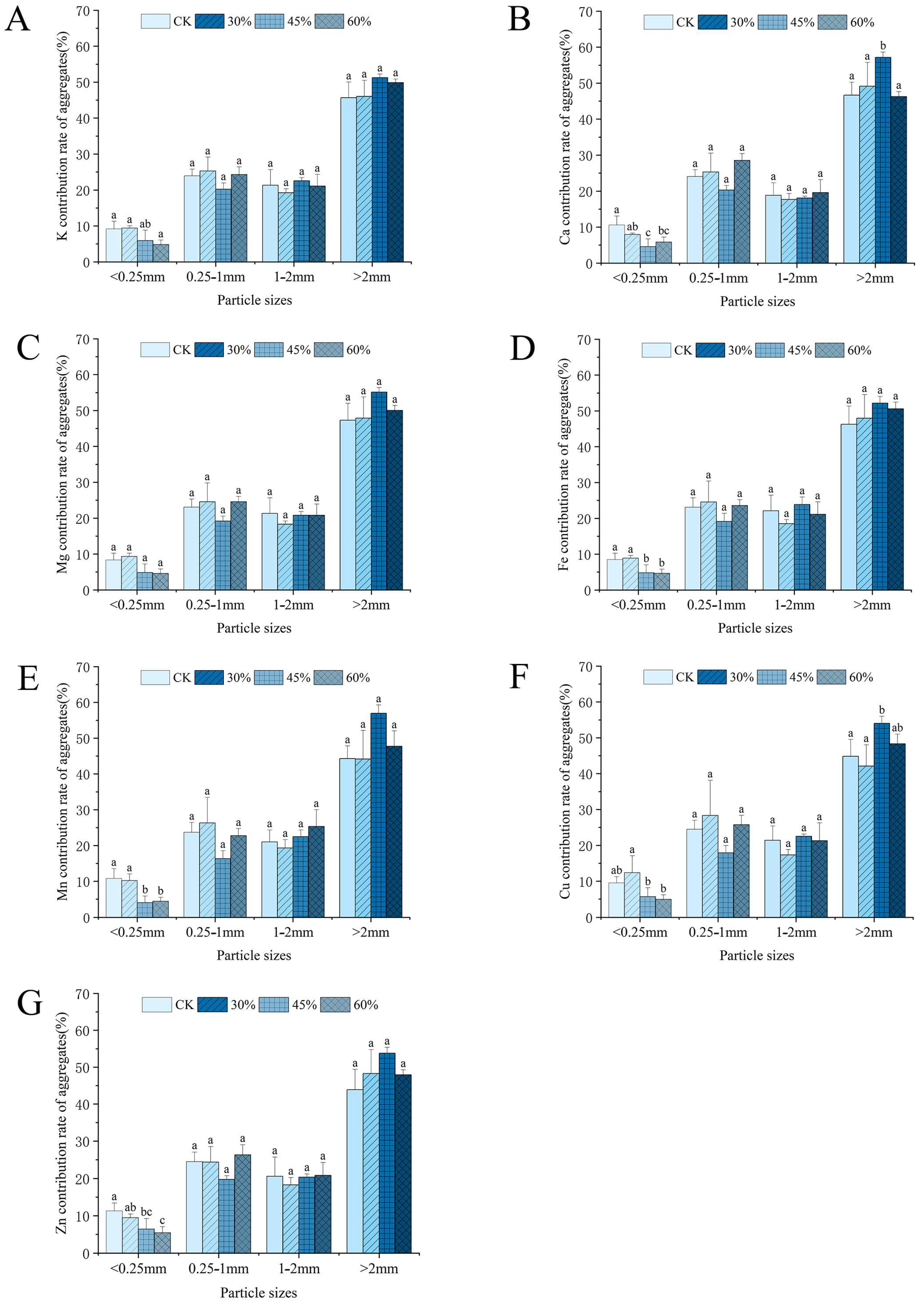

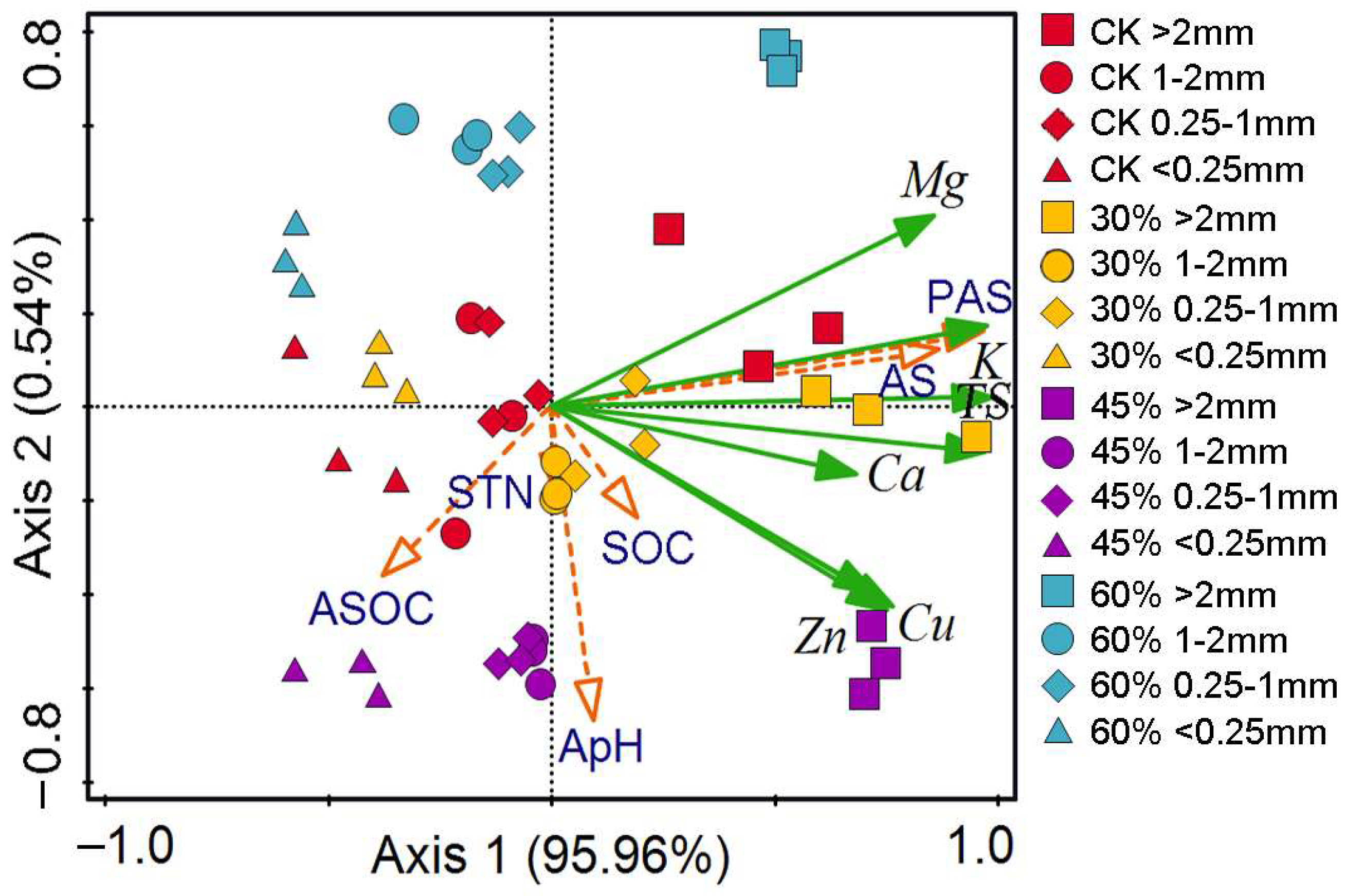
| Thinning Intensity | Number of Trees (Tree/ha) | Tree Height (m) | Diameter at Breast Height (cm) | Aspect | Slope Degree (°) |
|---|---|---|---|---|---|
| CK | 1380 | 23 | 27 | Northwest | 25 |
| 30% | 966 | 23 | 26 | Northwest | 27 |
| 45% | 759 | 22 | 26 | Northwest | 23 |
| 60% | 552 | 22 | 27 | Northwest | 24 |
| Soil Factor | Thinning Intensity | |||
|---|---|---|---|---|
| CK | 30% | 45% | 60% | |
| SBD (g/cm3) | 1.38 ± 0.14 b | 1.26 ± 0.13 b | 1.54 ± 0.10 a | 1.38 ± 0.12 b |
| SCP (%) | 33.67 ± 3.62 b | 38.09 ± 4.60 ab | 40.35 ± 5.99 a | 37.39 ± 4.32 ab |
| SNCP (%) | 7.92 ± 2.79 b | 13.02 ± 5.12 a | 6.19 ± 4.26 b | 7.53 ± 4.24 b |
| STP (%) | 41.59 ± 0.92 b | 51.10 ± 4.77 a | 46.54 ± 5.66 ab | 44.92 ± 3.25 b |
| SWC (%) | 15.73 ± 0.29 c | 21.25 ± 0.71 a | 20.11 ± 0.38 b | 19.80 ± 0.13 b |
| SpH | 4.42 ± 0.09 b | 4.39 ± 0.05 b | 5.51 ± 0.03 a | 4.47 ± 0.04 b |
| SOC (g/kg) | 17.56 ± 1.33 b | 21.98 ± 0.68 a | 15.41 ± 0.38 c | 13.84 ± 0.21 d |
| STN (g/kg) | 1.03 ± 0.07 b | 1.32 ± 0.06 a | 1.09 ± 0.01 b | 0.91 ± 0.02 c |
| STP (g/kg) | 0.20 ± 0.00 b | 0.28 ± 0.00 a | 0.21 ± 0.01 b | 0.28 ± 0.01 a |
| SAN (mg/kg) | 3.45 ± 0.45 b | 3.43 ± 0.63 b | 4.29 ± 0.74 a b | 5.01 ± 0.86 a |
| SNN (mg/kg) | 6.92 ± 0.14 a | 7.08 ± 0.15 a | 4.00 ± 0.16 c | 6.56 ± 0.16 b |
| SAP (mg/kg) | 4.63 ± 0.46 c | 6.77 ± 0.48 b | 2.15 ± 0.30 d | 21.37 ± 1.68 a |
| Soil Factor | Size | Thinning Intensity | |||
|---|---|---|---|---|---|
| CK | 30% | 45% | 60% | ||
| AWC (%) | <0.25 mm | 11.83 ± 0.28 Bc | 15.97 ± 0.07 Aa | 14.70 ± 0.02 Ab | 11.02 ± 0.09 Bd |
| 0.25–1 mm | 13.31 ± 0.26 Ac | 15.71 ± 0.06 Aa | 13.83 ± 0.25 Bb | 11.15 ± 0.15 Bd | |
| 1–2 mm | 12.82 ± 0.14 Ab | 14.88 ± 0.41 Ba | 12.35 ± 0.17 Db | 10.99 ± 0.31 Bc | |
| >2 mm | 12.99 ± 0.34 Ab | 15.21 ± 0.02 Ba | 13.02 ± 0.22 Cb | 11.55 ± 0.17 Ac | |
| ApH | <0.25 mm | 4.46 ± 0.04 Ac | 4.50 ± 0.04 Ac | 5.87 ± 0.02 Ba | 4.80 ± 0.05 Ab |
| 0.25–1 mm | 4.43 ± 0.04 Ad | 4.53 ± 0.04 Ac | 5.93 ± 0.02 Ba | 4.79 ± 0.08 Ab | |
| 1–2 mm | 4.52 ± 0.14 Ac | 4.55 ± 0.03 Ac | 5.93 ± 0.03 Ba | 4.72 ± 0.02 Ab | |
| >2 mm | 4.46 ± 0.04 Ad | 4.54 ± 0.01 Ac | 6.23 ± 0.06 Aa | 4.79 ± 0.03 Ab | |
| ASOC (g/kg) | <0.25 mm | 21.10 ± 0.07 Ac | 31.89 ± 0.92 Aa | 24.28 ± 0.56 Ab | 18.14 ± 0.42 Ad |
| 0.25–1 mm | 18.81 ± 0.26 Bc | 24.32 ± 0.56 Ba | 22.34 ± 0.66 Bb | 18.58 ± 0.80 Ac | |
| 1–2 mm | 15.55 ± 0.09 Cb | 19.28 ± 0.42 Ca | 18.83 ± 0.05 Ca | 15.71 ± 0.38 Bb | |
| >2 mm | 15.13 ± 0.54 Cc | 17.42 ± 0.48 Db | 19.10 ± 0.41 Ca | 15.62 ± 0.17 Bc | |
| ATN (g/kg) | <0.25 mm | 1.38 ± 0.04 Ab | 1.93 ± 0.04 Aa | 1.86 ± 0.04 Aa | 1.25 ± 0.05 Ac |
| 0.25–1 mm | 1.22 ± 0.02 Bc | 1.57 ± 0.04 Bb | 1.67 ± 0.09 Ba | 1.27 ± 0.02 Ac | |
| 1–2 mm | 1.02 ± 0.01 Cd | 1.29 ± 0.01 Cb | 1.44 ± 0.02 Da | 1.08 ± 0.05 Bc | |
| >2 mm | 0.98 ± 0.02 Cd | 1.13 ± 0.05 Db | 1.54 ± 0.02 Ca | 1.05 ± 0.02 Bc | |
| ATP (g/kg) | <0.25 mm | 0.24 ± 0.02 Ad | 0.32 ± 0.00 Ac | 0.54 ± 0.03 Ba | 0.37 ± 0.01 Bb |
| 0.25–1 mm | 0.23 ± 0.01 Ad | 0.31 ± 0.01 ABc | 0.76 ± 0.01 Aa | 0.39 ± 0.01 Ab | |
| 1–2 mm | 0.21 ± 0.00 Bd | 0.29 ± 0.02 Bc | 0.53 ± 0.03 Ba | 0.37 ± 0.01 Bb | |
| >2 mm | 0.21 ± 0.01 Bd | 0.29 ± 0.01 Bc | 0.56 ± 0.02 Ba | 0.39 ± 0.01 Ab | |
| AAN (mg/kg) | <0.25 mm | 5.87 ± 0.19 Aa | 5.01 ± 0.43 Ab | 5.31 ± 0.43 Aab | 1.98 ± 0.10 Ac |
| 0.25–1 mm | 3.59 ± 0.24 Bb | 1.60 ± 0.02 Cd | 4.71 ± 0.25 Aa | 2.20 ± 0.19 Ac | |
| 1–2 mm | 2.98 ± 0.08 Cb | 2.58 ± 0.16 Bb | 4.66 ± 0.41 Aa | 1.62 ± 0.21 Bc | |
| >2 mm | 3.79 ± 0.18 Ba | 3.20 ± 0.83 Ba | 3.92 ± 0.22 Ba | 1.33 ± 0.16 Bb | |
| ANN (mg/kg) | <0.25 mm | 19.98 ± 0.01 Bc | 28.38 ± 0.45 Ab | 45.14 ± 0.93 Aa | 20.79 ± 0.15 Ac |
| 0.25–1 mm | 20.57 ± 0.47 Ac | 22.83 ± 0.36 Bb | 31.11 ± 0.64 Ba | 19.30 ± 0.40 Bd | |
| 1–2 mm | 16.83 ± 0.24 Cb | 16.67 ± 0.35 Cb | 25.10 ± 0.43 Ca | 15.54 ± 0.71 Cc | |
| >2 mm | 15.69 ± 0.09 Db | 15.62 ± 0.18 Db | 23.21 ± 0.62 Da | 15.14 ± 0.22 Cb | |
| AAP (mg/kg) | <0.25 mm | 5.62 ± 0.16 Ac | 7.17 ± 0.06 Bc | 107.13 ± 4.26 Ca | 44.80 ± 0.48 Cb |
| 0.25–1 mm | 4.23 ± 0.19 Bc | 5.67 ± 0.55 Bc | 229.50 ± 14.75 Aa | 54.35 ± 0.97 ABb | |
| 1–2 mm | 3.93 ± 0.19 BCc | 5.83 ± 1.27 Bc | 134.71 ± 4.96 Ba | 50.97 ± 3.22 Bb | |
| >2 mm | 3.62 ± 0.29 Cd | 21.95 ± 12.75 Ac | 133.67 ± 10.40 Ba | 56.02 ± 3.23 Ab | |
| Soil Factor | Explanation (%) | Contribution (%) | Pseudo-F | p |
|---|---|---|---|---|
| SpH | 66.3 | 68.3 | 90.7 | 0.002 |
| SOC | 22.6 | 23.2 | 91.5 | 0.002 |
| ApH | 3.5 | 3.6 | 20.3 | 0.002 |
| ASOC | 1.2 | 1.2 | 7.9 | 0.002 |
| STN | 0.4 | 0.5 | 3.1 | 0.052 |
| MWD | 0.6 | 0.6 | 4.4 | 0.058 |
| GMD | 0.2 | 0.2 | 1.8 | - |
| SBD | 0.6 | 0.6 | 5.1 | 0.062 |
| SCP | 0.9 | 0.9 | 9.6 | - |
| AS | 0.2 | 0.2 | 2.2 | 0.096 |
| PAS | 0.2 | 0.2 | 2.3 | 0.100 |
| TH | <0.1 | <0.1 | 0.1 | 0.884 |
| STP | <0.1 | <0.1 | 0.4 | 0.662 |
| Soil Factor | Explanation (%) | Contribution (%) | Pseudo-F | p |
|---|---|---|---|---|
| PAS | 89.6 | 91.4 | 397 | 0.002 |
| SOC | 3.6 | 3.6 | 23.4 | 0.002 |
| ApH | 2.2 | 2.2 | 20.5 | 0.002 |
| STN | 0.5 | 0.5 | 4.7 | 0.018 |
| ASOC | 0.4 | 0.4 | 4.7 | 0.034 |
| AS | 0.3 | 0.3 | 4.0 | 0.028 |
| SBD | 0.3 | 0.3 | 3.5 | - |
| MWD | 0.3 | 0.3 | 3.8 | 0.056 |
| SpH | 0.2 | 0.2 | 3.0 | - |
| DBH | 0.1 | 0.1 | 1.8 | 0.166 |
| STP | <0.1 | <0.1 | 0.5 | 0.528 |
| SNCP | <0.1 | <0.1 | <0.1 | 0.880 |
Disclaimer/Publisher’s Note: The statements, opinions and data contained in all publications are solely those of the individual author(s) and contributor(s) and not of MDPI and/or the editor(s). MDPI and/or the editor(s) disclaim responsibility for any injury to people or property resulting from any ideas, methods, instructions or products referred to in the content. |
© 2025 by the authors. Licensee MDPI, Basel, Switzerland. This article is an open access article distributed under the terms and conditions of the Creative Commons Attribution (CC BY) license (https://creativecommons.org/licenses/by/4.0/).
Share and Cite
He, X.; Lu, Z.; Yang, J.; Cheng, F. Size Composition, Stability, and Distribution of Metal Nutrient Elements of Soil Aggregates of Eucalyptus Plantations with Different Thinning Intensities. Forests 2025, 16, 609. https://doi.org/10.3390/f16040609
He X, Lu Z, Yang J, Cheng F. Size Composition, Stability, and Distribution of Metal Nutrient Elements of Soil Aggregates of Eucalyptus Plantations with Different Thinning Intensities. Forests. 2025; 16(4):609. https://doi.org/10.3390/f16040609
Chicago/Turabian StyleHe, Xiaofang, Zhenxia Lu, Jian Yang, and Fei Cheng. 2025. "Size Composition, Stability, and Distribution of Metal Nutrient Elements of Soil Aggregates of Eucalyptus Plantations with Different Thinning Intensities" Forests 16, no. 4: 609. https://doi.org/10.3390/f16040609
APA StyleHe, X., Lu, Z., Yang, J., & Cheng, F. (2025). Size Composition, Stability, and Distribution of Metal Nutrient Elements of Soil Aggregates of Eucalyptus Plantations with Different Thinning Intensities. Forests, 16(4), 609. https://doi.org/10.3390/f16040609






